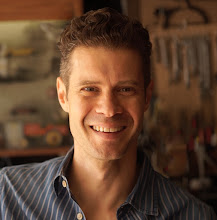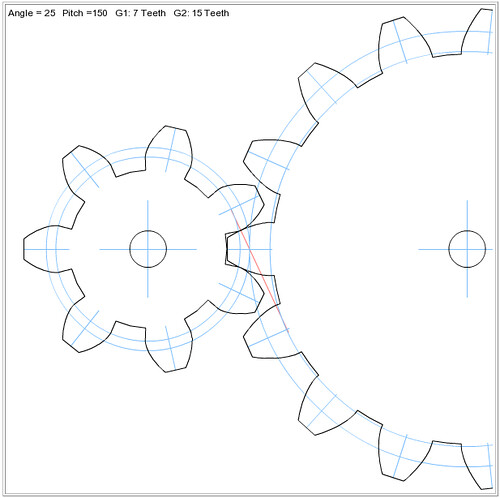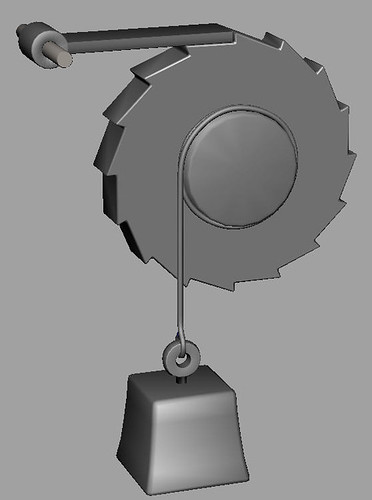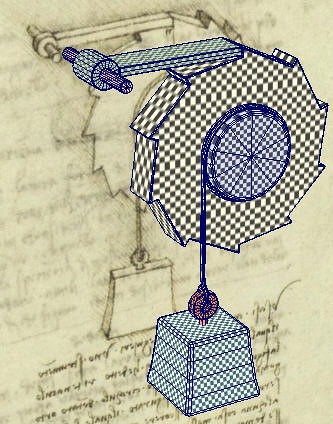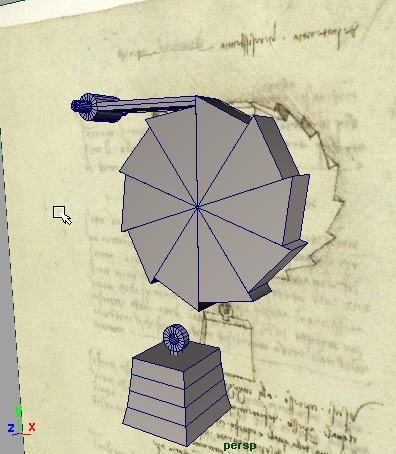Matthias Wandel is a woodworker who has created a wonderful, interactive wooden gear template generator. I'd love to port some of these ideas to a MEL script within Maya so I can automate 3D gear creation.
October 11, 2007
September 28, 2007
Il volo instrumentale
This is a wooden kit made by The Imagination Factory that I'd like to build. There are other kits for different da Vinci machines out there, but this one seems to be in a class of its own.
September 05, 2007
More coiling rope
September 01, 2007
Rope coil test
August 28, 2007
Rigid body dynamics simulation
I'm using a rigid body dynamics simulation to get the pawl to react properly when the ratchet rotates clockwise.
Here's what I did:
- I turned the ratchet into a passive rigid body, meaning it collides with active rigid bodies, but it is unaffected by external forces.
- I turned the pawl into an active rigid body, so that it reacts to forces (such as gravity) and collisions (the ratchet bumping into it). This would normally send it flying off into space, like a baseball being hit by a bat, so on to the next step.
- I added a hinge constraint to the pawl rigid body. I moved this constraint to the center of the pawl's rod end. This prevents the pawl from moving, and forces it to rotate about a single axis. I also created a gravity field to pull the pawl back down once it's bounced up a bit.
August 26, 2007
Attention to detail
My friend Phil Zucco, an awesome 3D modeler and all-around great guy, pointed out to me that I'd modeled my ratchet with too few teeth, compared to the da Vinci sketch. I have no idea what I was thinking and how I managed to do that. My intention was to count the teeth and build a cylinder with twice the number of spans as teeth. I wasn't even close!
So, here's a the new, correct (I hope) ratchet.
August 22, 2007
Ratchet and pawl

Here is a description of the ratchet and pawl, from Cornell University's wonderful Kinematic Models for Design Digital Library:
The ratchet and pawl mechanism allows motion in one direction but locks it in the other direction. In this sense it acts in the same way as a diode in an electrical circuit or a check value in a water pipe. The ratchet and pawl was often used with a winch or windlass, a horizontal drum with a rope or cable attached, which allowed the rope to be wound onto the cylinder but prevented the cylinder from unwinding the rope. Reuleaux was fascinated with ratchet mechanisms and designed several different models to illustrate the different motions and uses of the ratchet. In his machine design book The Constructor (1893), he defined the ratchet in the similar way as Leonardo da Vinci; "The object of the ratchet is to check the action of certain portions of a machine and so modify an otherwise continuous motion into some intermittent form." (Page 150). The use of control valves in steam engines and internal combustion engines in the 19th century to regulate speed represented the beginnings of automatic control of machines. Reuleaux recognized the importance of control but did not have the mathematical concepts to describe it. He saw instead the special digital nature of ratchet mechanisms, on or off, as having special significance in machine regulation and created several models to express the role of ratchets in machine control devices.
August 19, 2007
Ratchet UVs
I've applied a checkerboard texture to each piece of the model. At first, the checkers look stretched out. After correcting the UV mapping coordinates on each model they look much more uniform.
If you're new to the concept of UV mapping, you'll probably still remember this one from school: how do you wrap a flat map around a globe, and vice versa? That's the same sort of problem as UV mapping. The answers lie in various types of projections. I used a mix of planar and cylindrical projections, along with some automatic layout tools and a bit of manual editing.
Once each object has reasonably good UV mappings, I'll be able to create materials for them, such as wood, rope, and iron.
Ratchet working file
I'm placing all of my work under Creative Commons attribution licensing, which means you can use it for anything you feel like, including commercial purposes, so long as you give credit to the original creator (me!).
August 18, 2007
Ratchet modeling continues
I've beveled all of the edges and added a couple of parts. I think this is meant to have a central hub around which the rope wraps. Starting to think about rigging, too. Rope is not straightforward in rigging, so I may end up rebuilding the rope model in a straight line, and then using the rig I build to coil it over the hub.
August 16, 2007
Ratchet bevel
August 15, 2007
Ratchet model proportions
Ratchet wheel image plane
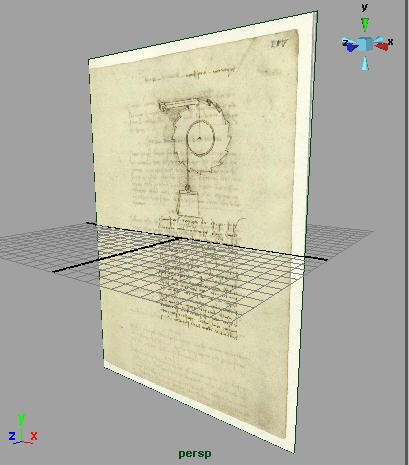
Ratchet wheel translation
 For the sake of having fun with this, I'm going to avoid existing research as much as possible and just try to see what the da Vinci notes and sketches themselves reveal.
For the sake of having fun with this, I'm going to avoid existing research as much as possible and just try to see what the da Vinci notes and sketches themselves reveal.In order to do this, I've convinced my Mom (who is Italian, with a degree from the University of Rome) to see what she can translate from these notes.
I've flipped the notes to "un-mirror" them, since Leonardo wrote many of his notes in a mirrored script. I think I read once that this was probably to avoid smearing the ink, since he was a lefty.
